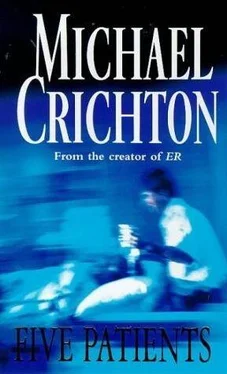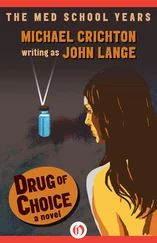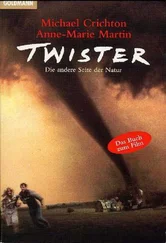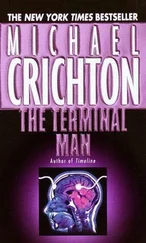Michael Crichton - Five Patients
Здесь есть возможность читать онлайн «Michael Crichton - Five Patients» весь текст электронной книги совершенно бесплатно (целиком полную версию без сокращений). В некоторых случаях можно слушать аудио, скачать через торрент в формате fb2 и присутствует краткое содержание. Жанр: Триллер, на английском языке. Описание произведения, (предисловие) а так же отзывы посетителей доступны на портале библиотеки ЛибКат.
- Название:Five Patients
- Автор:
- Жанр:
- Год:неизвестен
- ISBN:нет данных
- Рейтинг книги:5 / 5. Голосов: 1
-
Избранное:Добавить в избранное
- Отзывы:
-
Ваша оценка:
- 100
- 1
- 2
- 3
- 4
- 5
Five Patients: краткое содержание, описание и аннотация
Предлагаем к чтению аннотацию, описание, краткое содержание или предисловие (зависит от того, что написал сам автор книги «Five Patients»). Если вы не нашли необходимую информацию о книге — напишите в комментариях, мы постараемся отыскать её.
Five Patients — читать онлайн бесплатно полную книгу (весь текст) целиком
Ниже представлен текст книги, разбитый по страницам. Система сохранения места последней прочитанной страницы, позволяет с удобством читать онлайн бесплатно книгу «Five Patients», без необходимости каждый раз заново искать на чём Вы остановились. Поставьте закладку, и сможете в любой момент перейти на страницу, на которой закончили чтение.
Интервал:
Закладка:
The only way to beat the dozing off is to ask questions. Supposedly this makes the learning experience more active, less passive. But, as anyone who has ever attempted to put together a programmed text knows, teaching by questions is extraordinarily difficult. The ideal set of questions is graded, going from fact to fact, leading the student from information he knows well to the reasoning out of information he does not know. On the other hand, the usual unplanned set of questions just draws a blank look and a guess.
For some reason, the question-and-answer teaching method is a peculiarity of professional school instruction. It is common in law, medicine, and business, and practically unknown in other graduate fields. The best teachers can employ it to great effect; most teachers are hopeless at it.
The system is most likely to succeed when applied to an individual-and almost certain to fail when applied to large groups. I have watched a specialist in diabetes walk into a room full of third-year students, rub his hands together, and say: "All right. Let's suppose you've gotten your diabetic patient. He has a blood sugar of three hundred. What kind of diet are you going to put him on?" Nobody in the room had the faintest idea what kind of diet to put him on. "How many grams of carbohydrate do you want to give him?" the instructor demanded. Nobody knew; nobody said anything. Finally he pointed to a student and insisted on a figure. "Ninety grams?" the student said. "Wrong!" said the instructor, and went around the room until somebody finally guessed one hundred grams, the figure he wanted to hear. "Now then, how much insulin do you want to start him with?" the instructor asked, and the game began again.
It would be pleasant to think such examples atypical of medical education, but in fact they are more the rule than the exception. Considerable dedication is required of students to learn medicine in the face of such teaching; one often has the impression that medical education works despite itself.
Useful changes can be made in all elements of the process^-changes in the students, changes in the teachers, changes in the teaching methodology. Of these, only one appears very likely: the traditional routine of every-other-night for clinical students and house officers is dying. Many hospitals are shifting to an every-third-night schedule, which makes a considerable difference. The student or house officer sleeps through his first night off, but he is able to read during the second night; and during the day he is more alert, more awake. This helps to remove one of the oldest paradoxes in medical education-namely that the hospital claims to provide an excellent learning environment, while systematically depriving its students of sleep.
A change in teachers is less likely. Clinical teaching posts have status attached to them; a private man likes to be able to say he "spends some time with the students." At the same time, teaching hasn't got much value as a way to be promoted within the academic hierarchy; medicine, like every other field, puts its emphasis on published research. This leads to a multitude of rather casual teachers who may spend only a few hours a year with the students. These people-like the diabetes expert, who comes to the hospital once every three months to deliver his little talk-are most pernicious. They do not care enough about teaching to attempt to do it well; they don't have enough experience with students to know how to direct their talk; they have never received any training in exposition and attach no significance to a good delivery.
Having dismissed these people, one should say that medicine does indeed correctly sense that private, experienced practitioners have accumulated practical knowledge that ought to be communicated to students. Unfortunately, this is not the way to do it.
Methods of teaching require considerable revision. You can be assured that this is taking place-it is always taking place and always has been. Curricula change, new courses spring up and others die, grand lectures on education are given citing Gushing and Osier, but somehow the fundamental quality of medical education remains the same.
The methodology continues to be perplexing. The notion that the subject should be suited to the manner of teaching; the idea that certain things are best taught in lectures, others in seminars, others individually; the understanding of those qualities that distinguish the lecture from the slide from the
printed page from the visceral experience-all these things are traditionally lacking in medicine.
Future medical educators, for example, will probably look back on the teaching hospital and shake their heads at the way "patient material" was used. One can argue that this use, at the present time, is highly inefficient. The individual patient in a teaching hospital is not intensively used for teaching. A bizarre case may be seen by fifty or sixty people, but the average ward patient is seen by many fewer, particularly if his problem is common and his stay in the hospital is short.
The need to see patients firsthand is an important part of medical education; one must have experience with many ill individuals, exhibiting many different manifestations of disease. This is necessary because there are both many diseases, and many forms that a disease will take in different people. To obtain the proper depth and breadth of experience requires a long time; a student or house officer must remain in the hospital at all hours for many years. Otherwise, he is going to miss vital experiences.
However, a number of ways of "saving the patient for future reference" are now possible. Teaching collections of X rays have existed for several years, enabling students to gain broad radiological experience without waiting for the patients actually to come in. But this is only the beginning: one can record a patient's appearance and important physical findings on video tape; one can even record an interview and history-taking. By such techniques literally hundreds of students can, over a period of years, have some experience with a given p;
And one can go further. For example, one n most severe limitations of modern clinical tea is that the student cannot really use the pati«"practice on." While mistakes are an imp* part in any learning process, in the hospita are discouraged and guarded against-and n so.
What is needed, of course, is a disposable tient, for whom mistakes do not matter. In the one can argue, the disposable patient was pro by society in the form of the charity case (at this was the popular belief); but this requiu can now be provided by technology. Anesti have developed a lifelike plastic dummy i for students to practice on; this dummy can allergic reactions to anesthesia, cardiac and n atory arrests, and a variety of other serious ci cations. The student can practice on the di«with impunity. So far, the only analogous sin is that provided by the post-mortem patient used for practice of surgical procedure. B» will see much more in the future.
For example, a teaching program can be pii a computer, enabling the student to ask ttu tient" questions, and get back replies. On th-. of such an interview, the student can make a nosis and institute therapy. The computer car inform the student of the consequences of hi scribed regimen.
In fact, such methods are already in usual Board Examinations, Part III-the section to interns prior to certification. The exam imong other things, film clips of patullowed by questions about the patient's It also contains a most interesting section if brief histories, followed by specific such as "What would you do immedi- iiis patient?" After each question is a :ssible answers, such as "Begin intrave- :eplacement," "Start antibiotics," "Give iid so on. And following each answer is 'lit space.
nt selects the therapy he wants and er- acked-out space to reveal the conse- his choice. If he has chosen correctly, i will be encouraging: "Patient im- Hut if he is wrong, the answer is likely to Patient dies."
Читать дальшеИнтервал:
Закладка:
Похожие книги на «Five Patients»
Представляем Вашему вниманию похожие книги на «Five Patients» списком для выбора. Мы отобрали схожую по названию и смыслу литературу в надежде предоставить читателям больше вариантов отыскать новые, интересные, ещё непрочитанные произведения.
Обсуждение, отзывы о книге «Five Patients» и просто собственные мнения читателей. Оставьте ваши комментарии, напишите, что Вы думаете о произведении, его смысле или главных героях. Укажите что конкретно понравилось, а что нет, и почему Вы так считаете.









